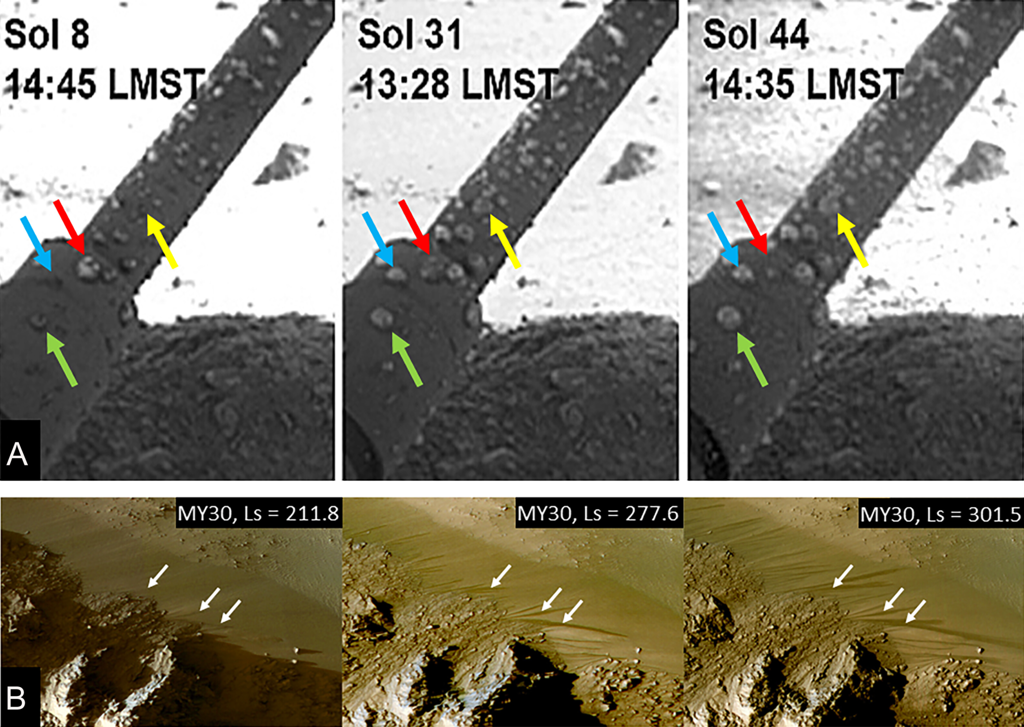Planetologists have clarified the "elusiveness" of water on Mars.
There is no doubt that billions of years ago, Mars had rivers, lakes, seas, and entire oceans. For instance, the surface features numerous winding structures that geologists can instantly identify as the beds of dried-up rivers. Additionally, clay minerals have been discovered on the Red Planet, and clay only forms in the presence of liquid water.
The question of where the Martian hydrosphere has gone is another matter: whether it largely evaporated into space or "went underground," meaning it became incorporated into the structure of solid rocks. In any case, the Red Planet still retains significant amounts of water ice not only in its polar caps: satellite instruments have detected that it is hidden beneath layers of regolith at lower and even mid-latitudes.
In 2008, the lander "Phoenix" dug a small trench on the surface of Mars, revealing something white beneath the reddish soil. When this white substance partially disappeared four days later, NASA officially stated: it was water ice that was sublimating—transitioning directly into a gaseous state.
Unfortunately, for water to exist in a liquid state on the surface of Mars, the Red Planet requires a higher atmospheric pressure. Nevertheless, throughout each long Martian year (which lasts as long as 1.8 Earth years), planetary scientists observe intriguing seasonal changes: during warmer periods, narrow and long vertical streaks appear on slopes in equatorial and mid-latitudes. Notably, these streaks are absent in winter. This is one of the key arguments supporting the theory that these are water flows. Scientists also suggest that groundwater may seep to the surface in certain areas.
According to researchers, Martian water is likely to be a briny solution—a highly concentrated salt solution. As is well known, salt acts as an "antifreeze": it makes water more resistant to cold, preventing it from freezing even in severe frost. In the case of Mars, the ideal type of salts for creating such non-freezing liquid are perchlorates—salts and complex esters of hydrochloric acid. With these, water would not freeze even at minus 75 degrees Celsius, while the average temperature on Mars is minus 58, occasionally reaching around plus 20.
By the way, the aforementioned "Phoenix" discovered traces of perchlorates on the Red Planet. An even more intriguing picture emerged when tiny round white structures were observed on the lander's support legs: there is strong suspicion that these are frozen droplets of that very brine.

Recently, all these facts and hypotheses were summarized by researchers from the University of Arkansas and the Lunar and Planetary Institute in Houston, USA. They presented their findings in an article for the journal Proceedings of the National Academy of Sciences, and these conclusions turned out to be quite discouraging.
The scientists believe that there are extremely few perchlorates in the ice on Mars, which means that suitable brines could only form in "microscopic" amounts. Furthermore, according to the authors of the article, even if such liquid existed, it would likely be unsuitable for potential life on Mars due to its very low so-called water activity—its "availability" for chemical reactions and biological processes.
Planetary scientists emphasized that, despite all this, they do not consider liquid Martian brines completely unrealistic, but their possibility would depend on an unlikely coincidence of sufficiently favorable conditions and the presence of the necessary salts. As for the seasonal streaks on the slopes, they may turn out to be traces of sand and dust flows, the scientists concluded.